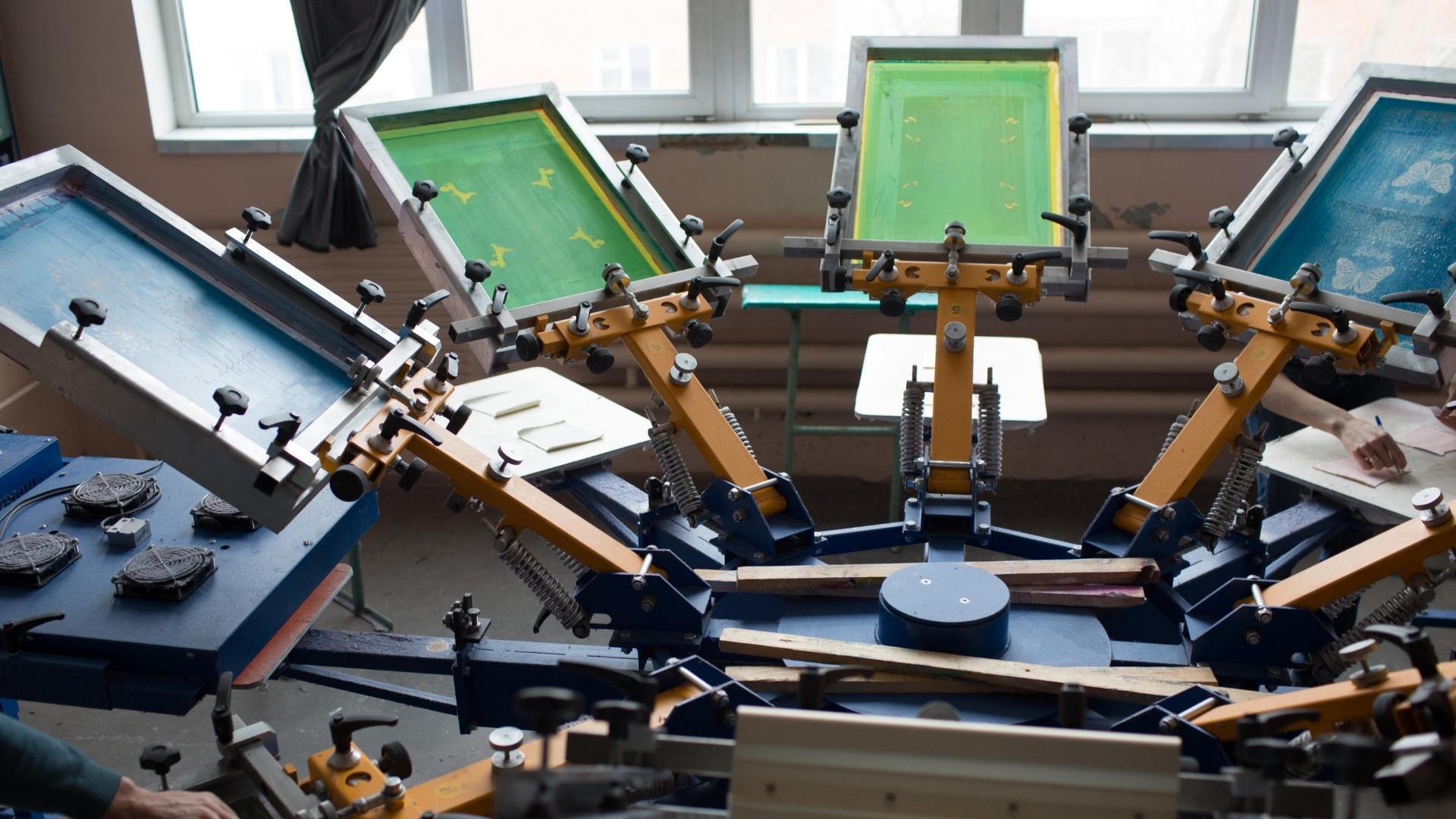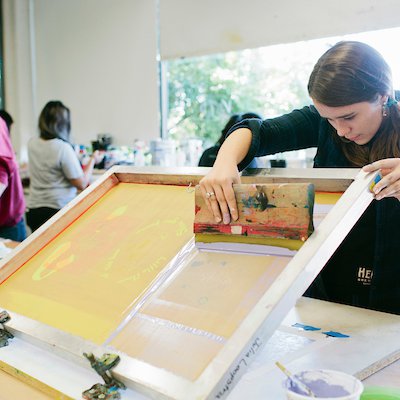ChatGPT said: How to get quick answers through 10:9 Design contact for your next order
Discover the Numerous Kinds Of Screen Printing Techniques for Your Next Task
Screen printing provides a varied variety of methods that can enhance any innovative job. From typical techniques like serigraphy to modern developments such as direct-to-garment printing, each technique has its unique advantages. Specialty alternatives, consisting of environment-friendly and metal inks, introduce also much more possibilities. Comprehending these techniques can considerably impact the final end result. The difficulty lies in picking the most ideal technique for particular demands and desired impacts. What variables should one think about?

The Fundamentals of Screen Printing
Screen printing may appear complicated, it is essentially a simple procedure that involves transferring ink with a mesh screen onto different surface areas. The technique starts with the production of a pattern, which specifies the layout to be printed. This pattern is affixed to a mesh screen, generally constructed from polyester or nylon. When the stencil remains in location, ink is used to the screen and pushed through the mesh using a squeegee, resulting in the desired pattern being printed on the underlying product.
Screen printing can be executed on a variety of substratums, including textile, paper, and plastic, making it a flexible choice for numerous tasks. The procedure permits for elaborate designs and dynamic colors, making it prominent in markets such as art, style, and marketing. Comprehending these basics outfits people with the foundational understanding required to explore more innovative techniques in screen printing.
Traditional Screen Printing Techniques
Conventional screen printing methods have actually been utilized for centuries, protecting the workmanship and virtuosity of this technique. This approach makes use of a mesh screen to move ink onto a substrate, such as material or paper, permitting for lively and lasting styles. The procedure starts with developing a stencil, which blocks certain locations of the screen to manage where the ink will be applied.
One prominent technique is serigraphy, typically made use of for limited editions and imaginative prints. One more is making use of water-based inks, which are environment-friendly and supply a soft feel on fabrics - 10:9 Design near me. In addition, standard methods can consist of hand-operated printing, where artisans use ink with a squeegee, ensuring accuracy and attention to information
These techniques continue to be valued in the sector for their responsive quality and the one-of-a-kind appearances they generate, interesting both customers and developers that appreciate the heritage of screen printing.
Digital Screen Printing Innovations
As the need for faster manufacturing and customization in the printing sector has risen, digital screen printing advancements have emerged as a game-changer. This modern technology blends standard screen printing methods with digital procedures, enabling for quick prototyping and detailed styles that were previously tough to accomplish. One substantial development is the introduction of direct-to-garment (DTG) printing, which facilitates high-quality, full-color prints on different textiles without the requirement for screens. Furthermore, innovations in ink formulations have actually brought about environment-friendly alternatives that preserve dynamic colors while lessening ecological effect. Making use of automated systems better simplifies production, decreasing labor prices and enhancing precision. These technologies not only deal with little batch orders and individualized layouts yet also enable quicker turnaround times, making them optimal for businesses concentrated on conference client demands in a fast-paced market. Digital screen printing, consequently, stands for a vital advancement in the domain of printing techniques.
Specialized Screen Printing Approaches
Discovering specialized screen printing techniques exposes a varied selection of techniques that push the borders of creative thinking and functionality in the printing market. Amongst these, glow-in-the-dark inks provide an unique visual result, making designs come to life in low-light problems. Metallic inks, understood for their shimmering surface, include a touch of luxury to printed products. Another ingenious technique is discharge printing, which gets rid of dye from the material as opposed to including ink, resulting in a soft, classic feel. High-density printing develops a raised texture on the surface area, boosting responsive involvement. In addition, water-based inks are gaining popularity for their lively colors and lowered environmental influence. Each of these specialized methods satisfies specific style requirements, enabling artists and brand names to develop standout products that reverberate with their audiences. By leveraging these techniques, companies can raise their screen printing projects to brand-new heights, making certain remarkable impacts.
Eco-Friendly Screen Printing Options
Environmentally friendly screen printing alternatives are acquiring traction as the industry changes towards sustainability. Lasting ink selections and the usage of biodegradable materials are crucial elements in reducing the environmental impact of the printing process. By taking on these methods, screen printers can add to a more lasting future while preserving premium outcomes.
Lasting Ink Options

Biodegradable Products Usage
As the screen printing industry advances, the consolidation of eco-friendly products is ending up being increasingly crucial for ecologically conscious methods. learn this here now Designers and producers are currently exploring inks and substrates made from natural, renewable energies that decompose extra efficiently than typical equivalents. These biodegradable choices lower plastic waste and minimize ecological influence, straightening with the expanding demand for lasting items.
Typical examples include water-based inks and organic cotton textiles, both of which reduce harmful chemicals and promote eco-friendliness. Brand names that embrace these products usually boost their market appeal, bring in consumers that prioritize sustainability. As awareness of environmental issues proceeds to climb, the change in the direction of eco-friendly materials in screen printing is likely to acquire energy, fostering a greener market standard.
Picking the Right Technique for Your Project
How can one determine one of the most appropriate screen printing method for a certain project? The decision hinges on several aspects, including the material to be printed on, the complexity of the style, and the preferred manufacturing volume - 10:9 Design LLC Company. Direct-to-garment printing is perfect for intricate layouts with numerous shades, while conventional screen printing succeeds for larger runs of simpler graphics.
Additionally, factor to consider of the end-use of the printed thing is necessary. For outdoor applications, methods that use resilience and climate resistance, such as plastisol ink, might be chosen. Conversely, environmentally-conscious jobs might take advantage of biodegradable materials or water-based inks.
Inevitably, understanding the job's distinct demands permits an enlightened selection, making sure both aesthetic allure and functional longevity. By examining design intricacy, material compatibility, and production range, one can effectively pick one of the most proper screen printing strategy to satisfy their job's goals.
Regularly Asked Inquiries
What Is the Background of Screen Printing?
Screen printing came from ancient China around 1000 ADVERTISEMENT, progressing through Japan and Europe. By the 20th century, it became prominent in commercial art and fashion, reinventing how layouts were generated and distributed worldwide.

How Do I Prepare Art Work for Screen Printing?
To prepare art work for screen printing, one should guarantee high resolution, utilize an ideal color mode, produce different layers for every shade, and convert message to describes, assuring compatibility with the printing procedure and preferred outcome.
What Products Are Finest for Screen Printing?
The ideal materials for screen printing consist of high-quality inks, durable displays, and suitable substrates like cotton, polyester, or blends. Furthermore, using ideal solution and squeegees can enhance the printing procedure and results.
Can I Screen Print in the house?
Yes, screen printing at home is feasible. With the right products, setup, and methods, individuals can produce high-grade prints. However, careful consideration of work area and devices is necessary for effective results.

What Are Common Mistakes in Screen Printing?
Typical blunders in screen printing consist of incorrect exposure times, Get More Info insufficient ink consistency, misalignment of displays, not enough cleansing of materials, and neglecting to evaluate prints. These mistakes can endanger the high quality and precision of the final item.
Screen printing may appear complicated, it is essentially a simple process that entails moving ink through a mesh screen onto various surfaces. As the demand for faster manufacturing and modification in the printing industry has surged, digital screen printing developments have actually emerged as a game-changer. Exploring specialty screen printing methods reveals a diverse selection of strategies that push the borders of creative thinking and capability in the printing sector. The ideal materials for screen printing include premium inks, sturdy displays, and appropriate substrates like cotton, polyester, or blends (10:9 Design Texas). Usual blunders in screen printing consist of inappropriate direct exposure times, poor ink uniformity, imbalance of displays, not enough cleansing of materials, and ignoring to check prints